Tags
Daly family, irish writer, james joyce, leo daly, local historian, mullingar connection, mullingar county library, mullingar., Obituary, Waldron, Westmeath Examiner
Mullingar mourns the late Leo Daly
A man described by ‘Mullingar: Just for the Record’ author Matt Nolan as “the essence of Mullingar” passed to his eternal reward on Saturday last, July 3.  Author, broadcaster, playwright, photographer, poet and renowned local historian Leo Daly (90) died peacefully in the care of nurses and staff at St. Clair’s Nursing Home, St. Francis’ Private Hospital, Ballinderry, Mullingar on Saturday night.
Author, broadcaster, playwright, photographer, poet and renowned local historian Leo Daly (90) died peacefully in the care of nurses and staff at St. Clair’s Nursing Home, St. Francis’ Private Hospital, Ballinderry, Mullingar on Saturday night.
Husband of the late Brigid, Mullingar native Leo was considered one of the town’s greatest ambassadors to arts and literature circles, building up a reputation throughout his long life as one of the county’s most knowledgeable historians, a prolific writer and a Joycean scholar par excellence.
Born in Mullingar on January 23, 1920 – just as the War of Independence got underway in Westmeath and the rest of the country – Leo was the son of William Daly, a local CIE engine driver, and Rebecca (née Forman). One of seven children (five brothers and one sister), as a child Leo lived at Fairgreen, Mullingar. He was educated at the Presentation Convent, Mullingar and later St. Mary’s CBS Boy’s National School, before acquiring his secondary education at Coláiste Mhuire’s Hevey Institute.
He joined the staff of St. Loman’s Hospital, Mullingar, where he garnered a reputation as a caring and highly professional psychiatric nurse; he retired early from this career in 1966, to concentrate on other areas of his life. Leo studied drama and drama writing in London under the British Drama League, and also completed a course in photography at the Agfa School of Photojournalism in Edenbridge, Kent. This training stood greatly to Leo throughout his professional life. While working at St. Loman’s, he also developed a trade as a professional photographer, and as a photojournalist, he made numerous contributions to American and Irish publications. He was a long-time and highly-regarded contributor to the Westmeath Examiner newspaper, and indeed, in 1982, edited this newspaper’s centenary publication. A lover of drama from an early age, Leo was a founder of the Mullingar Little Theatre, and produced and acted in numerous plays. He featured in the “Midland Herald” and the “Roscommon Herald” as a drama critic, and wrote pantomime scripts for the St. Loman’s Players. In the 1950s, he produced “The Bachelors’ Times”, a brochure reproduced annually in connection with the Mullingar Bachelors’ Ball. Shortly before his retirement from St. Loman’s, with the assistance of his daughter Rosaleen, Leo produced an adaptation of A.J. Stanley’s three-act comedy “The Troubled Bachelors”.
A gifted creative writer, Leo was a Hennessy Award-winning short story writer. Two of his stories, “The Echo” and “The Awakening”, were published in the Irish Press in 1969. These works earned him an invitation to the David Marcus School for Short Storywriters. A Joycean scholar of note, and the author of “James Joyce and the Mullingar Connection”, Leo travelled to many international symposia on Joyce over the years, preparing papers and sharing thoughts and ideas with other experts on the works of James Joyce and his contemporaries. A well known broadcaster, Leo wrote extensively for radio and theatre audiences, and was a regular contributor to the arts and culture show, “Sunday Miscellany” on RTÉ Radio 1. Prolific and versatile in output, his name featured in countless newspapers and magazines even into his later years; one of the most unusual publications he wrote for was Cara, Aer Lingus’ in-flight magazine. History was one of his greatest loves, and he will forever be remembered in Mullingar and Westmeath for his encyclopaedic knowledge of local history, particularly the minutiae of medieval and pre-medieval Mullingar. His 1999 work on the life of St. Colman of Lynn, for example, is a monumental local study of early Christian Ireland.
Leo also played a major role in the digitisation of Mullingar’s parish records. A keen promoter of the Irish language, Leo developed a great love for the Aran Islands, and often travelled there. His celebrated novel, “The Rock Garden” (1984), is set on Aran, and gives the reader a glimpse at social and cultural issues surrounding the islands. A former resident of 10 Mary Street, Mullingar, Leo spent his last years at St. Clair’s Nursing Home, Ballinderry. Rev. Fr. Colm Browne (CC, Mullingar), led tributes to Leo as he was removed from his son Bill’s home at Lynn, Mullingar on Monday evening last, to the Cathedral of Christ the King. Fr. Browne celebrated Requiem Mass for the repose of his soul on Tuesday morning, as huge crowds turned out to pay their respects to Leo, the Daly family and extended families.
He is survived by his children Rosaleen, Kathleen, Louise, William, Eugene, John, Justine and Bridaine, brothers Frank and Gavan, sons-in-law, daughters-in-law, sisters-in-law Rose, Mary Jo, Trina, Eithne and Lily, grandchildren, great-grandchildren, relatives and a large circles of friends and former colleagues. Leo was laid to rest at Ballyglass Cemetery, Mullingar after Mass on Tuesday morning.
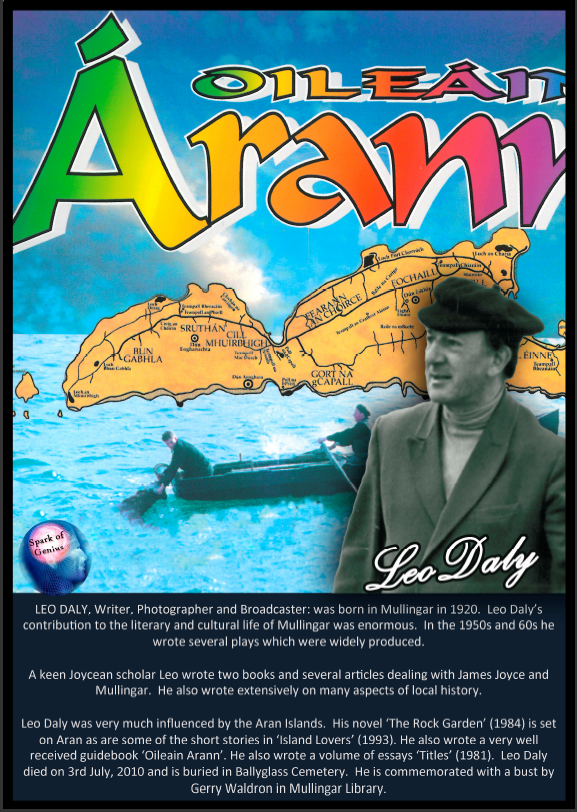
Poster by permission, Gearóid O Brien
Sculptor Gerry Waldron with the bust of Leo Daly, which is now in Mullingar.
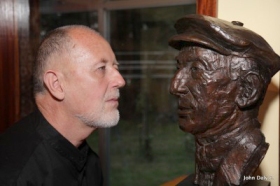 Sculptor Gerry Waldron carried home to Mullingar this week a precious cargo: his newly-cast bust of the late Mullingar writer, Leo Daly. And, he admits, he is delighted with how the work has turned out. “I modelled it in clay, and I brought it to the foundry and had it cast in bronze,” says Gerry, adding that he was delighted that the foundry, in Putney in London, gave the work some priority, and began work on it straight away. The bust is to be placed at the Library in Mullingar, a fitting place for a man who left behind him a huge opus of written work, not just prose, but poetry; and also some very valuable photographs, and this week, at his home, Gerry is to show the bust to Leo’s family. It’s clear that Gerry felt a huge sense of responsibility when asked to create the piece: “When I got the email, I had just finished a lovely head of a man from Glana, and I was really pleased with it, and the very next day I got the email from William Daly saying I had the commission.
Sculptor Gerry Waldron carried home to Mullingar this week a precious cargo: his newly-cast bust of the late Mullingar writer, Leo Daly. And, he admits, he is delighted with how the work has turned out. “I modelled it in clay, and I brought it to the foundry and had it cast in bronze,” says Gerry, adding that he was delighted that the foundry, in Putney in London, gave the work some priority, and began work on it straight away. The bust is to be placed at the Library in Mullingar, a fitting place for a man who left behind him a huge opus of written work, not just prose, but poetry; and also some very valuable photographs, and this week, at his home, Gerry is to show the bust to Leo’s family. It’s clear that Gerry felt a huge sense of responsibility when asked to create the piece: “When I got the email, I had just finished a lovely head of a man from Glana, and I was really pleased with it, and the very next day I got the email from William Daly saying I had the commission.
At first, I was a bit nervous about it, as normally the person is alive, but Leo’s family were very good in providing photos, and I knew him so well myself – I used to always visit him in the nursing home – and he was always very supportive of me.” Gerry says he worked “intensely” and “intensively” on the bust, and was lucky that everything went very smoothly. “”It’s exciting when you are working in clay to see the person emerge, and I worked on it very lovingly, and I could see Leo emergning from the clay as I worked – lovingly – on it,” he says.
A big admirer of Leo’s, Gerry admits he was delighted that Leo’s son William travelled to London to view the work, and was happy with it. “I am completely satisfied with it myself,” Gerry says. A full-time painter and sculptor, Gerry is a Mullingar man, who, like Leo, studied at Coláiste Mhuire. He has had a number of exhibitions at the Arts Centre in Mullingar.
Mullingar County Library a tribute to Leo
Source Photographic Archive

Bust presentation and unveiling.
Leo Daly , Mullingar
A Brief Profile and List of Writings
- Page 1
- Page 2
- Page 3
- Page 4
- Page 5
- Page 6
- Page 7
- page 8
1 December 2009
Dear Uncle Leo,
I hope this finds you well and in good spirits.
…………Leo, I’m glad I undertook this little piece of research on my “famous uncle”, I am informed, impressed and indeed proud. I’m sorry that I don’t have your gift with letters to do your profile justice—but I’m sure you will forgive me!
Wishing you a Very Happy Special Birthday in January. Be proud of your achievements and celebrate! Mullingar is so lucky to have you!
Leo and his brother Gavin, 1933. (http://www.topic.ie/)
A contribution by Louise Prangle, daughter of Leo Daly
– read at Westmeath Archaeological and Historical Society’s 35th anniversary meeting; a special evening of tributes to Leo who was first Chairman of the Society.
19th April 2013 at the Greville Arms Hotel, Mullingar.
First I would like to thank the Archaeological and Historical Society for organising this commemoration for Leo. He was indeed a “Mullingar man” and he made a large contribution to the cultural life of Mullingar.
Before I read a few paragraphs from his “Edy and Edie” included in his “James Joyce at the Cross Keys Mullingar”, I would like to give you an idea of my relationship to my father’s ‘writings’.
Leo would spend a summer holiday with us – me, my husband Brian and our children – in Acocks Green, Birmingham, more or less annually following my mother’s death.
He always arrived very enthusiastic and his objectives for his holiday though unspoken were obvious. He came armed with sheaves of his current writings – which he hoped I might type up before he returned home.
Over the years of his visits he had established a few routines in Birmingham: one was visiting ‘Maxwell’, as he called him, at our local second hand book shop, alas no longer there. He would make many happy visits; happy to take time chatting and arriving back with a few treasured books for us and the children. He was always generous with his books.
Another routine was to spend many hours in Birmingham Library researching. He seemed to enjoy engaging the staff there in his search for obscure references .. and retrieving volumes from the archives.
A few days into his holiday Leo would reveal his main project. This usually involved me taking him on a long car journey – “it’s not very far” he would say, “just….” As he wasn’t a driver distances and routes didn’t seem to matter to him.
In 1994, the year following my mother’s death, his project was to complete his “Austin Friars” in Mullingar book. So, on this occasion the road trip was to Wales. One whole day driving to Wales and around the Black Mountains; seeking out and looking at churches; searching for saints’ wells. He made notes and took photographs as he went; then on to Capel-Y-Ffin and finally Llanthony Abbey. He gathered enough material on this day to complete the Wales section of his “Austin Friars” book demonstrating the historical links between the Augustinian friars in Wales and Mullingar.
So, why did I choose this reading from Leo’s “Edy and Edie”?
I remember reading a quote from an ‘interview’ with him published in a local paper where he said, something like “I don’t read Ulysses I dissect it”.
This piece “Edy and Edie” included in his “James Joyce at the Cross-Keys Mullingar” published in 1991, I think demonstrates this “dissecting”, and preoccupation with the minutiae of Joyce’s writings. Leo wrote it for the fiftieth anniversary of the death of Joyce.
I will now move on to Leo’s own words from the Introduction to this book, and then a brief reading illustrating his method of working.
Introduction (James Joyce at the Cross-Keys –Mullingar), page i (paragraph three).
“The article which follows seeks to present what the average reader appreciates as an extra bonus in Joyce; the tracing of allusions to characters real and imaginary, masked or exposed, and the topographical details surrounding them. A small few will follow the vague footprints left by Joyce when he wandered down the country, searching for further evidence of elusive past images in his writings such as Stephen Hero. A lucky researcher may discover an acquaintance, even a distant relation long since departed staring out at them from the Joycean page, and maybe wish he hadn’t.”
And this is the best way of remembering my father as to how he thought and worked. The piece is entitled: “Edy and Edie” each spelt differently.
“Edy and Edie” – pages 1and 2
As a local contribution to the anniversary celebration I was preparing for publication an investigation of a paragraph in Ulysses which, because of parenthetical variations proves meaningless in many editions of the novel but seems corrected in Hans Walter Gabler’s edition. I was on delicate ground because I was inferring that James Joyce had not had a full grasp of what he intended to write when he wrote this paragraph as he did. Nothing new about this, because Joyce himself admitted to hundreds – or was it thousands – of mistakes, and left his scrawled corrections on his proof pages for posterity to view.
Over the Christmas I was proceeding merrily, making excellent progress as my knowledge of parenthetical ellipses grew, and seeing the relative paragraph reveal its inconsistencies.
The allusions, punctuation and italicizing were fitting into place as I instinctively felt James Joyce had intended they should and I knew that the version now emerging would have his imprimatur if such were available.
Then, on New Year’s Day, a letter arrived. It was two months overdue although it had been posted in a neighbouring town, and I felt reluctant to open it as I didn’t welcome any deviation from the work in hand. However, feeling that its opening had been delayed long enough I succumbed.
The content of my New Year’s letter was far removed from the work I had been engaged in, introducing a startling new identification of a Joyce character, and at first sight a major discovery. I was stunned, although aware that such rewards are present for all researchers of Joyce, rewards which are both confusing and helpful, all being part of Joyce’s method of confusion and obfuscation. So one consoles oneself, but instead of leading me out of my difficulties, my friend’s New Year letter dropped me right back amongst the tenors to whom I had said goodbye in 1982, when I had set course in a different direction, submitting a feature for Radio which was broadcast as “Tenors in the life of James Joyce.. The relevant section of the New Year’s letter reads as follows:
“….. I was intrigued to hear of a reference some years ago in a Joyce T. V. play to Edy Boardman, a nursemaid whom Leopold Bloom met and dallied with on Sandymount Strand. I have often intended to contact some Joycean expert to discuss the subject, but never knew who until I read the recent article in the Irish Times on Mullingar and you. If you do not already know, I think I can identify the lady, and I enclose her (Edie Boardman’s) photograph taken when she was in her teens ….”
I stopped at that point, and then reread the complete letter a few times in an effort to assimilate the extraordinary inference of what the letter seemed to convey. I delayed for a day or two rereading the Nausicaa chapter of Ulysses in which Edy makes her appearance; Ellmann’s biography of Joyce where Edy had already been identified; other sources such as Stuart Gilbert’s Study of Ulysses and a name index of Ulysses; searching for all mentions of Edy Boardman. Despite the odds against the new identification of Edy Boardman I decided it was, at least, worth investigating.” ………..
And there I will leave Leo happily contemplating this little nugget he discovered over the Christmas and New Year Holiday of 1990/91.
Leo in Aran 60s and later visit with Tommy Roche (Roche T)

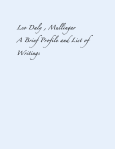

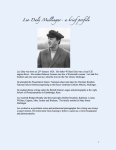


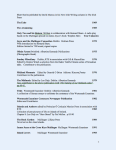


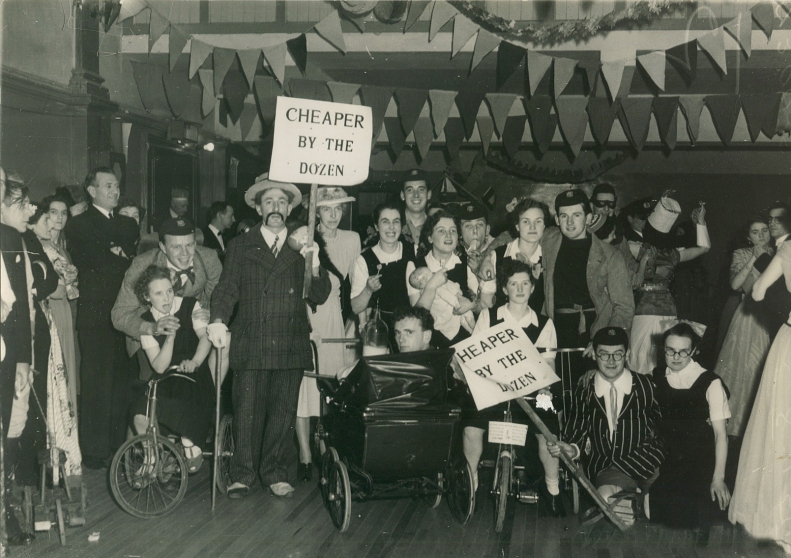

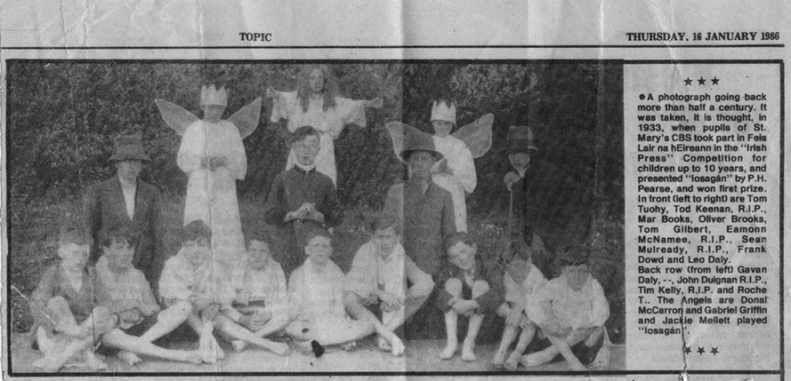

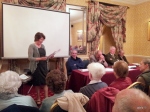


You must be logged in to post a comment.